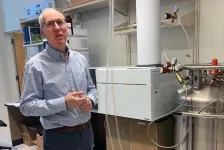(Press-News.org) UNDER EMBARGO UNTIL: Feb. 12, 2024, 4:30 PM EST
Media Contacts: Karen Addis, APR, karen@addispr.com, +1 (301) 787-2394; Kerri Wade, MPA, kwade@smfm.org, +1 (202) 236-1780
National Harbor, Md. -- Sepsis, a severe infection that can lead to tissue damage, organ failure, and death, is one of the top three causes of maternal deaths worldwide, according to the World Health Organization. The life-threatening emergency is largely preventable with early diagnosis and treatment and disproportionately affects pregnant people in low- and middle-income countries (LMICs).
In a new study to be presented today at the Society for Maternal-Fetal Medicine’s (SMFM) annual meeting, The Pregnancy Meeting™ researchers will unveil findings that suggest that giving an oral dose of azithromycin to pregnant people who deliver vaginally is a cost-saving treatment for reducing maternal sepsis, death or infection in developing countries.
Previous research found that administering a single oral dose of azithromycin to everyone in labor significantly reduced the risk of maternal sepsis or death in seven low- and middle-income countries. This latest study builds on that research by examining the costs versus benefits of using this intervention in these countries: Bangladesh, the Democratic Republic of the Congo, Guatemala, India, Kenya, Pakistan, and Zambia.
Using data from the Azithromycin Prevention in Labor Use (A-Plus) trial, researchers looked at the cost of giving the antibiotic to everyone in labor compared to the healthcare costs associated with treatment for people with sepsis and/or infection.
Results demonstrated that azithromycin is a low-cost intervention for preventing sepsis and the reduction in healthcare use, such as fewer hospital admissions and clinic visits, results in cost savings. For every 100,000 pregnancies, an oral dose of azithromycin prevented 1,592 cases of maternal sepsis, death or infection and 249 maternal hospitalizations. The cost of administering the antibiotic was 91 cents per pregnancy. The overall analysis demonstrated a cost-savings of $32,661 per 100,000 pregnancies.
“Sepsis remains a leading cause of maternal death globally, and the burden is greatest in low-resource settings,” says the study’s lead author Jackie Patterson, MD, associate professor of neonatal-perinatal medicine at the University of North Carolina’s School of Medicine in Chapel Hill. “Ministries of health have to weigh the various interventions at their disposal and decide how to best allocate the limited resources they have. It’s a big deal to have an effective therapy for maternal sepsis that is also cost-saving to implement in a low-resource setting.”
Presenting the research on behalf of Patterson was Alan Thevenet N. Tita, MD, PhD, a maternal-fetal medicine subspecialist at the University of Alabama at Birmingham Marnix E. Heersink School of Medicine, who was one of the study’s authors. Tita was also the lead author on the initial study that found that administering azithromycin to pregnant people who were delivering vaginally reduced the risk of maternal sepsis or death. That research was presented at the 2023 SMFM Annual Meeting and published in the New England Journal of Medicine.
The abstract was published in the January 2024 supplement of the American Journal of Obstetrics and Gynecology.
Additional news releases about select SMFM research being presented are posted on AAAS’s EurekAlert (subscription needed) approximately one week in advance of embargo lifting. Embargoes lift on the date and start time of the abstract presentation.
###
About the Society for Maternal-Fetal Medicine
The Society for Maternal-Fetal Medicine (SMFM), founded in 1977, is the medical professional society for maternal-fetal medicine subspecialists, who are obstetricians with additional training in high-risk pregnancies. SMFM represents more than 6,000 members who care for high-risk pregnant people and provides education, promotes research, and engages in advocacy to advance optimal and equitable perinatal outcomes for all people who desire and experience pregnancy. For more information, visit SMFM.org and connect with the organization on Facebook, Twitter, and Instagram. For the latest 2024 Annual Meeting news and updates, follow the hashtag #SMFM24.
END
New study finds commonly used antibiotic is a cost-saving treatment for reducing maternal sepsis, death or infection in developing countries
2024-02-12
ELSE PRESS RELEASES FROM THIS DATE:
Reshaping our understanding of granular systems
2024-02-12
Your morning cereal, a jar of nuts, the sands of distant planets, and even the concrete in your city are all examples of granular systems surrounding us. And such systems are harboring secrets that could change the way we mix things up.
In a new paper published in the journal Proceedings of the National Academy of Sciences (PNAS), scientists at the University of Rochester, including Rachel Glade, an assistant professor of earth and environmental sciences and of mechanical engineering; Fernando David Cúñez, a former postdoctoral research associate ...
Can hydrogels help mend a broken heart?
2024-02-12
You can mend a broken heart this valentine’s day now that researchers invented a new hydrogel that can be used to heal damaged heart tissue and improve cancer treatments.
University of Waterloo chemical engineering researcher Dr. Elisabeth Prince teamed up with researchers from the University of Toronto and Duke University to design the synthetic material made using cellulose nanocrystals, which are derived from wood pulp. The material is engineered to replicate the fibrous nanostructures and properties of human tissues, thereby recreating its unique biomechanical properties.
"Cancer is a diverse disease and two patients with the same type of cancer will often respond ...
New study finds that pregnancy complications can also affect child’s health later in life
2024-02-12
Hypertensive disorders of pregnancy (HDP) and gestational diabetes (GDM) are two of the most common pregnancy complications and put pregnant people at increased risk of developing cardiovascular disease later in life.
Now, in a new study to be presented today at the Society for Maternal-Fetal Medicine’s (SMFM) annual meeting, The Pregnancy Meeting™, researchers will unveil findings that suggest these pregnancy complications may also result in worse cardiovascular health for the child.
In a secondary analysis of 3,317 maternal-child pairings from the prospective Hyperglycemia ...
Scientists discover biological mechanism of hearing loss caused by loud noise – and find a way to prevent it
2024-02-12
Anyone who has ever been to a loud concert knows the feeling of ringing ears. Some people experience temporary or even permanent hearing loss or drastic changes in their perception of sound after the loud noises stop. Thanos Tzounopoulos, Ph.D., director of the Pittsburgh Hearing Research Center at the University of Pittsburgh School of Medicine has focused his scientific career on investigating how hearing works and developing ways to treat tinnitus and hearing loss.
In a paper published today in ...
Widespread machine learning methods behind ‘link prediction’ are performing very poorly
2024-02-12
As you scroll through any social media feed, you are likely to be prompted to follow or friend another person, expanding your personal network and contributing to the growth of the app itself. The person suggested to you is a result of link prediction: a widespread machine learning (ML) task that evaluates the links in a network — your friends and everyone else’s — and tries to predict what the next links will be.
Beyond being the engine that drives social media expansion, link prediction is also used in a wide range of scientific research, such as predicting the interaction between genes and proteins, and is used by researchers as a benchmark for ...
The hidden rule for flight feathers—and how it could reveal which dinosaurs could fly
2024-02-12
Birds can fly— at least, most of them can. Flightless birds like penguins and ostriches have evolved lifestyles that don’t require flight. However, there’s a lot that scientists don’t know about how the wings and feathers of flightless birds differ from their airborne cousins. In a new study in the journal PNAS, scientists examined hundreds of birds in museum collections and discovered a suite of feather characteristics that all flying birds have in common. These “rules” provide clues as to how the dinosaur ancestors of modern birds first evolved the ability to fly, ...
Machine learning promises to accelerate metabolism research
2024-02-12
A new study shows that it is possible to use machine learning and statistics to address a problem that has long hindered the field of metabolomics: large variations in the data collected at different sites.
“We don’t always know the source of the variation,” said Daniel Raftery, professor of anesthesiology and pain medicine at the University of Washington School of Medicine in Seattle. “It could be because the subjects are different with different genetics, diets and environmental exposures. Or it could be the way samples were collected and ...
Researchers uncover a key link in legume plant-bacteria symbiosis
2024-02-12
Legume plants have the unique ability to interact with nitrogen-fixing bacteria in the soil, known as rhizobia. Legumes and rhizobia engage in symbiotic relations upon nitrogen starvation, allowing the plant to thrive without the need for externally supplied nitrogen. Symbiotic nodules are formed on the root of the plant, which are readily colonized by nitrogen-fixing bacteria. The cell-surface receptor SYMRK (symbiosis receptor-like kinase) is responsible for mediating the symbiotic signal from rhizobia perception to formation of the nodule. ...
Genetic analysis and archaeological insight combine to reveal the ancient origins of the fallow deer
2024-02-12
Modern populations of fallow deer possess hidden cultural histories dating back to the Roman Empire which ought to be factored into decisions around their management and conservation.
New research, bringing together DNA analysis with archaeological insights, has revealed how fallow deer have been repeatedly moved to new territories by humans, often as a symbol of colonial power or because of ancient cultures and religions.
The results show that the animal was first introduced into Britain by the Romans ...
Researchers studying ocean transform faults, describe a previously unknown part of the geological carbon cycle
2024-02-12
Woods Hole, Mass. (February 12, 2024) – Studying a rock is like reading a book. The rock has a story to tell, says Frieder Klein, an associate scientist in the Marine Chemistry & Geochemistry Department at the Woods Hole Oceanographic Institution (WHOI).
The rocks that Klein and his colleagues analyzed from the submerged flanks of the St. Peter and St. Paul Archipelago in the St. Paul’s oceanic transform fault, about 500 km off the coast of Brazil, tells a fascinating and previously unknown story about parts of the geological ...






